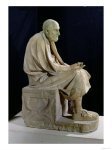Were Hand Gestures a Technique of Stoicism?
Were they a psychological technique?

Chrysippus Gesturing
Copyright (c) Donald Robertson, 2012. All rights reserved.
[This is still a draft, using material I'm researching for my next book, so please feel free to comment or raise questions, and I may revise the content accordingly.]
The early Stoics reputedly said that “knowledge is the leading part of the soul in a certain state, just as the hand in a certain state is a fist” (Sextus in Inwood & Gerson, 2008, The Stoic Reader, p. 27). This analogy between secure knowledge, having a firm grasp on an idea, and the physical act of clenching the fist seems to be a recurring theme in Stoic literature.
And Zeno used to make this point by using a gesture. When he held out his hand with open fingers, he would say, “This is what a presentation is like.” Then when he had closed his fingers a bit, he said, “Assent is like this.” And when he had compressed it completely and made a fist, he said that this was grasping (and on the basis o f this comparison he even gave it the name ‘katalepsis’ [grasp], which had not previously existed). But when he put his left hand over it and compressed it tightly and powerfully, he said that knowledge was this sort of thing and that no one except the wise man possessed it. (Cicero in Inwood & Gerson, 2008, p. 47)
The sculpture of Chrysippus in the picture above, from the 3rd century BC, shows him holding his hand out with open fingers, in a similar posture. So we have a series of four hand gestures:
The hand is held open, at a distance, with palm upwards, to symbolise a superficial impression or “presentation”.
The hand is closed loosely, to symbolise initial “assent” or agreement with the idea.
The hand is squeezed tightly into a fist to symbolise a firm grasp (katalepsis) or sense of certainty.
The fist is enclosed tightly in the other hand, to symbolise the perfect “knowledge” of true ideas attained by the ideal Sage, which is elsewhere described as an interconnection of firmly-grasped principles and ideas, forming the excellent character of the wise.
Marcus Aurelius refers to clenching the fist as thought it symbolises the act of the Stoic student in arming himself with his philosophical precepts.
The student as boxer, not fencer. The fencer’s weapon is picked up and put down again. The boxer’s is part of him. All he has to do is clench his fist. (Meditations, 12.9)
For the Stoics it was important to memorise the precepts and integrate them completely with one’s character in order to have them always “ready-to-hand” in the face of adversity. It’s possible that the physical act of literally clenching the fist, like a boxer, was used as a mnemonic to recall principles required in difficult situations.
It’s possible perhaps to construct a modern Stoic psychological exercise out of this symbolic set of hand gestures. While repeating a precept of Stoicism (“the only good is moral good”, “pain is not an evil”) the Stoic student might initially hold his hand open as if toying with the idea and then progressively close it more tightly, while imagining accepting it more deeply, until he finally clenches his fist tightly to symbolise having a firm grasp of the idea, and closes his other hand around it, to symbolise integrating it more deeply with his character. This might be compared to the use of “autosuggestions” or rehearsing “rational coping statements” in modern psychological therapies.
There may also be an additional use, in relation to false or irrational ideas. In the Enchiridion, Epictetus says that the first thing a Stoic should do when encountering a harsh (problematic) impression is to remind himself that it is merely an impression and not at all the thing it claims to represent. This sounds very much like an important psychological strategy used in modern CBT and behaviour therapy, called “cognitive distancing” or “defusion”. As it happens, Cicero says that the hand gesture demonstrated in the sculpture of Chrysippus above was used by Zeno and other Stoics to symbolise entertaining an idea, such as an “automatic negative thought”, in the form of a superficial “presentation” or impression. Hence, a modern Stoic might make the same gesture when he notices an unhelpful or irrational thought occurring spontaneously, and entertain it a while longer, as if holding it loosely in an open hand, at a distance, while repeating “This is just an automatic thought, and not at all the thing it claims to represent” or “This is just a thought, not a fact”, etc.
We don’t know whether the set of symbolic hand gestures described by Zeno was meant originally as a psychological technique of this kind. However, the quote from Marcus Aurelius above could perhaps be read, if taken very literally, as a description of an actual physical practice employed by Stoic students: clenching their fists to arm themselves, like a boxer, with their philosophical precepts (dogmata) in the face of adversity.
Filed under: Stoicism Tagged: Epictetus, marcus aurelius, stoic, stoicism





